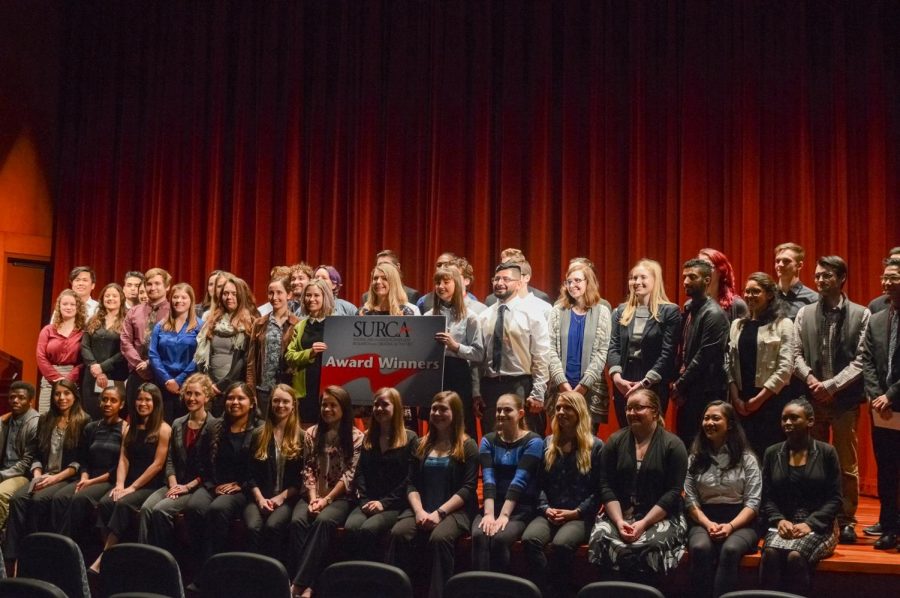Students showcase innovation, research questions
At SURCA, undergrads presented on varying topics, won awards
ADAM JACKSON | THE DAILY EVERGREEN
Participants of SURCA stand on stage after receiving awards for their presentations.
April 3, 2018
Students presented their research in topics ranging from artistic design to how various drugs impact the symptoms of terminal diseases at the seventh annual Showcase for Undergraduate Research and Creative Activities on Monday.
The research students present at SURCA can enhance a student’s undergraduate education by giving them the opportunity to research and connect with people of a similar discipline, said Shelley Pressley, director of WSU’s Office of Undergraduate Research.
She advises students to participate in SURCA to give them the opportunity to contribute new research to their field of study under the mentorship of a distinguished faculty member. The research conducted by the undergraduates will be preserved in electronic records as well so outside researchers are able to use the new information.
“WSU Libraries gives all presenters the chance to create a permanent record of their work by submitting digital copies of posters to the digital archive,” Pressley said.
Krista Brutman, a freshman majoring in mathematics, gave her presentation on collectivist feminism in modern China.
“Feminism in different countries slowly is evolving into a more progressive, outspoken movement where change is being seen, no matter how small,” Brutman said.
Brutman hopes her results will show that cultures are advancing in the movement for women’s rights with varying levels of progressiveness.
WSU senior Jay Jones presented his research on the use of the drug simvastatin in attempting to improve the symptoms of limb-girdle muscular dystrophy type 2I, or LGMD2I.
Jones said there currently is no cure for LGMD2I and the treatments available only target the signs and symptoms of a specific individual. In his research, he found that while simvastatin suppressed symptoms in one type of muscular dystrophy, it had no impact on the LGMD2I form.
“Although previous studies show that the drug simvastatin was a beneficial treatment of Duchenne muscular dystrophy,” Jones said, “the results from the study with LGMD2I showed the treatment was not as effective as hypothesized.”
Jones hopes his research, while not going according to plan, will eliminate the testing of the drug on LGMD2I so other labs can use resources to look into different drugs.
Noelle Perez, a WSU senior majoring in anthropology, presented her research on the study of which biological and sociological characteristics makes a human being.
Perez said her research originally examined the degree a student was working toward and how they defined the word human. Her research found a variety in answers from students with difference academic backgrounds, and that people were more well rounded and nuanced in their definition of humanness than she previously assumed.
Correction: This story has been revised to reflect the accurate spelling of Noelle Perez’s name. This story has also been updated to reflect that Perez’s research found that people from different backgrounds had nuanced answers when defining what is human, not that biology students defined humanity as related to morphology and DNA.









